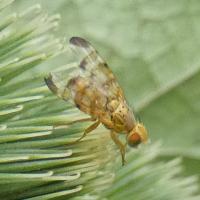Sphegina is a genus that looks like it's intermediate between Baccha and Neoascia. But separation of the species is not easy.
Many thanks Howard, that looks very promising, and will be my first encounter with the Milichiidae! I'll key it out properly when I get a chance, but Madiza pachymera also looks like a possibility, judging by Nigel Jones's photo here (which was also from a flight interception trap):
https://diptera.info/photogallery.php?photo_id=10342
Ken Smith's (yellow) book has a comprehensive list of references (albeit concentrating on the British Fauna).
The other book you should try to get is Aquatic Insects of North Europe, volume 2 - which is mostly Diptera. (editor Anders Nilsson). Again it has extensive lists of references at the end of each family chapter.
Hi - I think this is Terellia tussilaginis - but would be grateful if someone could confirm (I am not sure it there are any very similar species).
Insect was on Burdock near the River Stour in Merley, Dorset yesterday.
many thanks
Nick

I think that looks OK for tussilaginis; at least the other species that are found on burdock look a bit different
Hi Martin. Like Phil, I have joined in the hope that I can get some help with marine shoreline flies ID. I have logged in OK but I too am getting a message saying "You are not allowed to post new content on the forum". Any suggestions? Many thanks
This does indeed key out as Madiza pachymera - thanks again Howard for putting me on the right track.
Oh! Just taken another look and it may be an Anthomyiidae - the anal vein reaches the wing edge. It doesn't have the usual small bristle on its hind metatarsus though, or at least it is not evident.
I'd agree with Anthomyiidae - the combination of pale hairs under the scutellum and the anal vein reaching wing margin is pretty diagnostic.
Hi, I've been trying to find out about the status of this key, but with no luck so far. If I can get further information I'll let you know.
There is a key by Stuart Ball available on the old Dipterists' Forum website at http://www.dipteristsforum.org.uk/documents/Family%20Sciomyzidae%20v2.pdf . You may need to sign on as a member of the Dipterists Forum to access this.

Looks fine for a male inflata